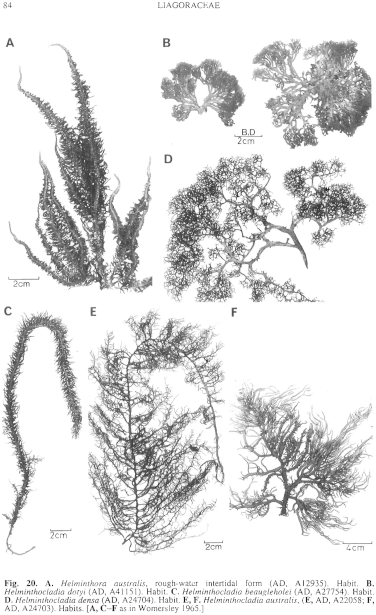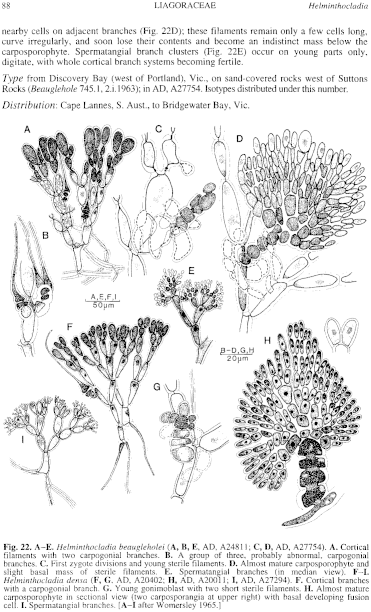|
|
|
|
|
|||||||||||
|
Electronic Flora of South Australia Species Fact Sheet
Phylum Rhodophyta – Class Florideophyceae – Order Nemaliales – Family Liagoraceae
Selected citations: Chapman 1969: 58, fig. 25. De Toni 1897: 83. Levring 1953: 495, figs 25E–K, 26; 1955: 418. Lucas & Perrin 1947: 133. Womersley 1965: 468, figs 40–45, pl. 4 fig. 2.
Synonyms
Helminthora densa (Harvey) Desikachary 1957: 454.
Nemastoma ? densa Harvey 1860a: 328.
Nemalion ? insigne Harvey 1863: pl. 284, synop.: xxxix. J. Agardh 1876: 508.
Thallus (gametophyte) (Fig. 20D) brownish purple, 10–25 cm high, with one to several terete, subdichotomous axes 2–4 mm in diameter, densely beset with short (0.5–3 cm long, 0.5–1 mm in diameter) subdichotomous laterals, forming a dense, bushy thallus; axes often denuded below. Holdfast discoid, 2–5 mm across; epilithic or on jetty piles. Structure of a medulla 0.2–0.5 mm broad in older ramuli, of fairly slender filaments [(2–) 4–8 µm thick] irregularly arranged, and a cortex (Fig. 22F) 100–200 µm broad, consisting of anticlinal filaments of elongate to ovoid cells, subdichotomously branched every 1 (–2) cells, terminal cells ovoid-pyriform, usually 15–20 (–25) µm long by 6–10 (–12) vm in diameter, scarcely larger than subterminal cells; rhodoplasts (Fig. 22I) irregularly stellate with a central pyrenoid; hairs often present on subterminal cells near branch apices.
Tetrasporophyte unknown.
Reproduction: Sexual thalli apparently dioecious. Carpogonial branches (Fig. 22F) 3-celled (very rarely 2), curved, laterally situated on the middle of the cortical filaments, with a conical carpogonium. First zygote division variable, sometimes almost transverse (Fig. 22G) with only the upper cell segmenting, or sometimes oblique and producing the gonimoblast directly; carposporophyte compact (Fig. 22H), with terminal ovoid carposporangia 12–18 Ilril long by 6–10 µm in diameter. Following fertilization, the carpogonial branch cells develop broader pit-connections (Fig. 22H) and some fusion (occasionally complete) of these cells occurs, but the lower gonimoblast cells are not involved. Mature carposporophytes are 60–140 µm across in surface view. Sterile post-fertilization filaments absent or slightly developed (Fig. 22G) adjacent to the carpogonial branch, irregular. Spermatangial clusters (Fig. 22I) borne on terminal cells of cortical filaments, digitate; spermatangial initials elongate, producing 1–3 spherical to ovoid spermatangia.
Type from Georgetown, Tas.; in Herb. Harvey, TCD.
Selected specimens: Antechamber Bay, Kangaroo I., S. Aust., upper sublittoral on piles (Woelkerling, 20.xi.1967; AD, A32054 -"Marine Algae of southern Australia" No. 68). Victor Harbor, S. Aust., upper sublittoral (Womersley, 28.i.1961; AD, A24704). Robe, S. Aust., upper sublittoral (Wollaston, 17.iii.1956; AD, A20402) and (Womersley, 29.i.1964; AD, A27294). Nora Creina, S. Aust., upper sublittoral pools (Womersley, 14.xi.1955; AD, A20011). Walkerville, Vic., below low tide (Sinkora A2330, 12.iii.1976; AD, A48488).
Distribution: New Zealand (?) (Kaikoura - Levring 1955, p. 418).
From Antechamber Bay, Kangaroo I., and Victor Harbor, S. Aust., to Walkerville, Vic., and the north coast of Tasmania.
Taxonomic notes: H. densa differs from all other species of Helminthocladia in its densely branched form, scarcely enlarged terminal cortical cells, and absence or slight development of sterile involucral filaments around the carposporophyte.
Abnormalities in H. densa are not uncommon. In the absence of fertilization, carpogonial branches may develop into a cortical branch, and short lateral branches may develop from the carpogonial branch cells.
References:
AGARDH, J.G. (1876). Species Genera et Ordines Algarum. Vol. 3, Part 1 - Epicrisis systematis Floridearum, pp. i-vii, 1–724. (Weigel: Leipzig.)
CHAPMAN, V.J. (1969). The marine algae of New Zealand. Part III: Rhodophyceae. Issue 1: Bangiophycidae and Florideophycidae (Némalionales, Bonnemaisoniales, Gélidiales). (Cramer: Germany.)
DE TONI, G.B. (1897). Sylloge Algarum omnium hucusque Cognitarum. Vol. 4. Florideae. Sect. 1, pp. 1–388. (Padua.)
DESIKACHARY, T.V. (1957). Helminthocladia from India and New Zealand. J. Indian Bot. Soc. 36, 441–456, Plates 15, 16.
HARVEY, W.H. (1860a). Algae. In Hooker, J.D., The Botany of the Antarctic Voyage. 111. Flora Tasmaniae. Vol. II, pp. 321–343, Plates 185–196.
HARVEY, W.H. (1863). Phycologia Australica. Vol. 5, Plates 241–300, synop., pp. i-lxxiii. (Reeve: London.)
LEVRING, T. (1953). The marine algae of Australia. I. Rhodophyta: Goniotrichales, Bangiales and Némalionales. Arkiv för Bot. Ser. 2, 2, 457–530.
LEVRING, T. (1955). Contributions to the marine algae of New Zealand. I. Rhodophyta: Goniotrichales, Bangiales, Némalionales and Bonnemaisoniales. Arkiv för Bot. Ser. 2, 3, 407–432.
LUCAS, A.H.S. & PERRIN, F. (1947). The Seaweeds of South Australia. Part 2. The Red Seaweeds. (Govt Printer: Adelaide.)
SCHMITZ, F. & HAUPTFLEISCH, P. (1896). Helminthocladiaceae, Chaetangiaceae. In Engler, A. & Prantl, K., Die nattirlichen Pflanzenfamilien. T. 1 Abt. 2, pp. 327–339. (Engelmann: Leipzig.)
WOMERSLEY, H.B.S. (1965). The Helminthocladiaceae (Rhodophyta) of southern Australia. Aust. J. Bot. 13, 451–487, Plates 1–7.
The Marine Benthic Flora of Southern Australia Part IIIA complete list of references.
Publication:
Womersley, H.B.S. (14 January, 1994)
The Marine Benthic Flora of Southern Australia
Rhodophyta. Part IIIA, Bangiophyceae and Florideophyceae (to Gigartinales)
Reproduced with permission from The Marine Benthic Flora of Southern Australia Part IIIA 1994, by H.B.S. Womersley. Australian Biological Resources Study, Canberra. Copyright Commonwealth of Australia.
Illustrations in Womersley Part IIIA, 1994: FIGS 20D, 22 F–I.

Figure 20 enlarge
Fig. 20. A. Helminthora australis, rough-water intertidal form (AD, Al2935). Habit. B. Helminthocladia dotyi (AD, A41151). Habit. C. Helminthocladia beaugleholei (AD, A27754). Habit. D. Helminthocladia densa (AD, A24704). Habit. E, F. Helminthocladia australis, (E, AD, A22058; F, AD, A24703). Habits. [A, C–F as in Womersley 1965.]

Figure 22 enlarge
Fig. 22. A–E. Helminthocladia beaugleholei (A, B, E, AD, A24811; C, D, AD, A27754). A. Cortical filaments with two carpogonial branches. B. A group of three, probably abnormal, carpogonial branches. C. First zygote divisions and young sterile filaments. D. Almost mature carposporophyte and slight basal mass of sterile filaments. E. Spermatangial branches (in median view). F–I. Helminthocladia densa (F, G, AD, A20402; H, AD, A20011; I, AD, A27294). F. Cortical branches with a carpogonial branch. G. Young gonimoblast with two short sterile filaments. H. Almost mature carposporophyte in sectional view (two carposporangia at upper right) with basal developing fusion cell. I. Spermatangial branches. [A–I after Womersley 1965.]

|
Email Contact: State Herbarium of South Australia |

|